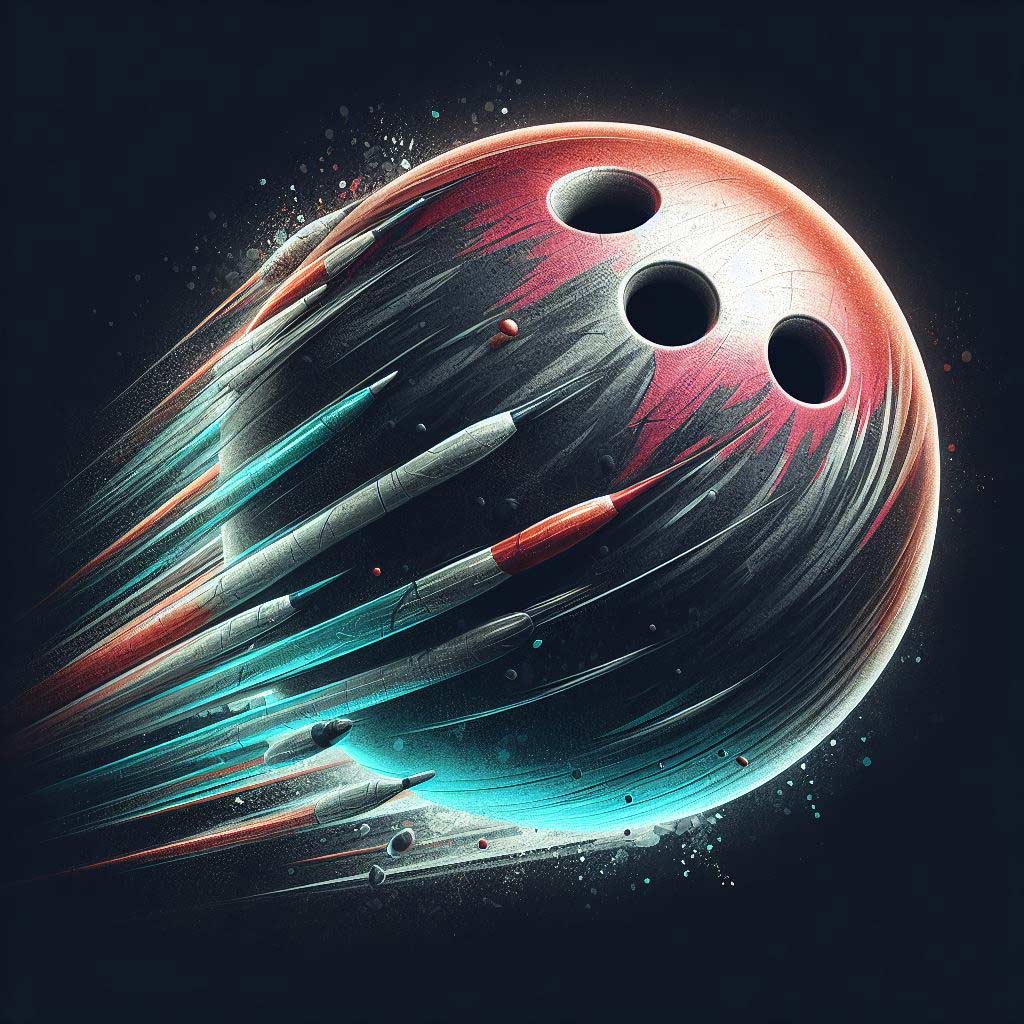As an avid bowler, you’ve probably invested a significant amount of time and money into finding the perfect bowling ball. But have you ever wondered just how long that ball will last you?
The lifespan of a bowling ball can vary greatly depending on a number of factors, from the material composition to your personal bowling habits.
Knowing the average lifespan of different bowling ball types and how to properly maintain your equipment is crucial for getting the most out of your investment and maintaining peak performance on the lanes.
In this comprehensive guide, we’ll dive into the details of bowling ball longevity – from what determines their usable lifetime to the telltale signs it’s time for a replacement.
What Determines a Bowling Ball’s Lifespan?
The longevity of a bowling ball is influenced by several key factors:
Material Composition
The material your bowling ball is made from plays a major role in its expected lifespan. The three most common bowling ball materials are:
- Plastic/Polyester: These are the most durable and basic bowling ball types. Plastic/polyester balls are known for their long-lasting, reliable performance, though they tend to have less hook potential compared to other ball types.
- Urethane: Urethane bowling balls offer a nice balance of durability and hook potential. They’re more reactive than plastic but not as aggressive as high-performance resin balls.
- Reactive Resin: Resin balls are the most technologically advanced, featuring a highly engineered coverstock that provides maximum hook and responsiveness. However, the complex materials used make them more prone to wear and tear over time.
Frequency of Use
How often you bowl with a ball is a major factor in its lifespan. Bowlers who hit the lanes multiple times per week will naturally see their balls wear out faster than someone who only bowls occasionally. The more you use a ball, the quicker the coverstock and other components will degrade.
Proper Care and Maintenance
Properly caring for and maintaining your bowling ball can significantly extend its usable lifetime. This includes regularly cleaning the surface, avoiding extreme temperatures, and getting the ball re-drilled when necessary. Balls that are neglected or abused will wear out much quicker.
Striking Surface Condition
The state of a bowling ball’s coverstock – the outer striking surface – is a major indicator of its remaining lifespan. As the coverstock becomes worn down, its responsiveness and hook potential will gradually diminish.
Average Lifespan of Different Bowling Ball Types
Now that we’ve covered the key factors, let’s take a closer look at the typical lifespans for the three main bowling ball materials:
Plastic/Polyester Bowling Balls
Plastic and polyester bowling balls are known for their exceptional durability and longevity. These basic ball types are designed to withstand extensive use and abuse on the lanes.
On average, a quality plastic/polyester ball can last bowlers anywhere from 5 to 10 years of regular use before performance starts to significantly degrade. Some bowlers have even reported using the same plastic ball for over a decade with proper maintenance.
The main factors that can impact the lifespan of a plastic/polyester ball include:
- Frequency of use: Bowlers who hit the lanes 2-3 times per week will likely see their plastic ball last 5-7 years, while more casual bowlers may get 8-10 years of use.
- Drilling/finger hole condition: Cracks, chips or enlarged finger holes can compromise a plastic ball’s structural integrity and performance.
- Surface wear: Over time, the outer coverstock will become dull and less responsive. Regular polishing and resurfacing can help extend its life.
With proper care and moderate use, a good quality plastic or polyester bowling ball can provide many years of reliable, consistent performance on the lanes.
Urethane Bowling Balls
Urethane bowling balls occupy a middle ground between the durability of plastic and the responsiveness of high-performance resin. They offer a nice balance of hook potential and longevity.
On average, a urethane bowling ball can be expected to last 3-6 years with regular use before its performance starts to degrade noticeably. However, this can vary quite a bit depending on factors like:
- Frequency of use: Serious bowlers using a urethane ball 2-3 times per week may only get 3-4 years of good use out of it. More casual players may see 5-6 years.
- Surface maintenance: Keeping the ball’s coverstock clean, polished and resurfaced can significantly extend its lifespan.
- Ball speed/rev rate: Harder-throwing bowlers with higher rev rates will tend to wear down urethane coverstocks faster than lower rev players.
While urethane balls are more durable than high-performance resin, they still require proper care and maintenance to maximize their lifespan. With the right approach, you can typically get 4-5 years of great use out of a quality urethane ball.
Reactive Resin Bowling Balls
Reactive resin bowling balls represent the pinnacle of modern bowling ball technology. These highly engineered balls provide superior hook potential and ball reaction, but their lifespan is generally shorter compared to plastic and urethane.
On average, a high-performance resin ball can be expected to last 2-4 years of regular use before its coverstock becomes too worn to provide optimal performance. Factors that influence resin ball lifespan include:
- Frequency of use: Bowlers who use a resin ball several times per week may only get 2-3 years of good use out of it. More casual players may push 3-4 years.
- Surface maintenance: Proper cleaning, polishing and resurfacing is crucial to extending the life of a resin ball’s coverstock.
- Ball speed/rev rate: High rev players and power bowlers will wear down resin coverstocks faster than lower rev rate bowlers.
While reactive resin balls provide unparalleled performance, their complex engineered materials make them more susceptible to wear and tear over time. Proper care and moderate use is key to getting the most out of these high-tech bowling balls.
Signs a Bowling Ball Needs to be Replaced
Even with the best care and maintenance, every bowling ball will eventually reach the end of its usable lifespan. Here are some of the telltale signs it may be time to replace your ball:
- Decreased Hook Potential – As the coverstock of a bowling ball becomes worn down, its ability to generate hook and overall ball reaction will gradually diminish. You may notice your ball no longer bites into the lane like it used to, resulting in a straighter, less responsive roll.
- Irregular Ball Motion – In addition to losing hook, a worn bowling ball may also exhibit inconsistent or unpredictable ball motion on the lane. This could manifest as the ball failing to read the lane properly, skidding or over-hooking unexpectedly.
- Visible Wear on the Coverstock – Carefully inspect the surface of your bowling ball. If you notice significant dulling, cracking, chipping or other visible signs of wear on the coverstock, it’s a clear indicator that ball needs to be replaced.
- Decreased Ball Weight – Over time, as a bowling ball’s coverstock wears down, the overall ball weight may decrease slightly. This subtle change in weight can negatively impact your ball’s performance and reaction.
If you start to notice any combination of these issues with your bowling ball, it’s generally a good sign that it’s time to start considering a replacement. Continuing to use a worn out ball will only lead to inconsistent and frustrating performance on the lanes.
Properly Maintaining a Bowling Ball
The good news is that with the right care and maintenance, you can significantly extend the usable lifespan of your bowling ball. Here are some tips for properly caring for your equipment:
- Cleaning and Polishing the Surface – Regularly cleaning and polishing the coverstock of your bowling ball is one of the most important maintenance tasks. Use a quality ball cleaner and polish to remove dirt, oil and other contaminants that can dull the surface over time. This helps maintain the ball’s responsiveness and hook potential.
- Storing the Ball Correctly – How you store your bowling ball when not in use can also impact its longevity. Avoid exposing the ball to extreme temperatures, moisture or direct sunlight, as these environmental factors can degrade the materials. Store your ball in a cool, dry place, ideally in a ball bag or case.
- Getting the Ball Re-Drilled – Over time, the finger holes in your bowling ball can become enlarged or misshapen due to wear. When this happens, it’s important to get the ball re-drilled to restore the proper fit and performance. Re-drilling can help extend the usable life of a ball by restoring its structural integrity.
By following these simple maintenance practices, you can help maximize the lifespan of your bowling ball and ensure it continues providing reliable, consistent performance on the lanes for years to come.
Conclusion
Knowing the average lifespan of different bowling ball types and how to properly care for your equipment is crucial knowledge for any serious bowler.
Plastic and polyester balls tend to be the most durable, lasting 5-10 years with regular use. Urethane balls offer a nice middle ground, lasting 3-6 years. High-performance resin balls provide the best performance but have the shortest lifespan at 2-4 years on average.
Regularly cleaning, polishing and maintaining your bowling ball’s surface, as well as getting it re-drilled when needed, can significantly extend its usable lifetime.
And being aware of the telltale signs it’s time for a replacement – like decreased hook potential, irregular ball motion, visible wear, and weight loss – will help you optimize your performance and investment.
Ultimately, the lifespan of your bowling ball comes down to a combination of the materials, your personal bowling habits, and how well you care for the equipment.
By understanding these factors, you can make informed decisions about when to upgrade your gear and get the most out of your bowling ball investment.





